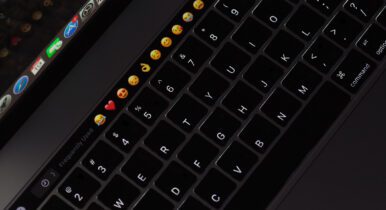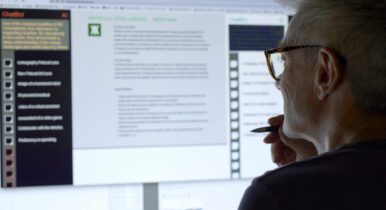How An Artistic Side Hustle Informs One Consultant’s Direct Mail Design

Eric Hogensen got his start as a campaign staffer. During a stint as a manager in 2004, he crossed paths with a mail consultant who brought him onboard after the cycle wrapped. When that apprenticeship ended, Hogensen, who also creates visual art and music on the side, went back to campaign staff work, eventually launching his own firm, HSG Campaigns, in 2007.
Hogensen spoke to C&E about direct mail, his approach to political design, and how he settles creative differences with clients.
C&E: Tell us about the creative you’re doing around COVID and education. Is the pandemic still a big part of your mail design?
Hogensen: It’s a huge part of it. Society’s look on schools has been intensified with COVID, for all the obvious reasons. School board races have a lot more attention, they’re attracting a lot more candidates and there’s obviously a whole subset of issues that are being brought into these races. It raises the profile of these campaigns, and that bleeds out into different aspects of the campaign, too. There’s just more to focus on, more to pay attention to, and they become more complex.
When it comes to communicating, one of the things that we’ve talked about with some of the folks we work with is getting a positive message out there from teachers and thanking the community for their support and helping with all of the difficult issues that came along with schooling and working remotely.
C&E: Will we see an evolution in direct mail this cycle?
Hogensen: When it comes to direct mail, I don’t think there’s a lot of room for innovation. I think it’s like, it is what it is. I do like innovation and thinking about the future and what it holds, but I’ve often come away from different, air quotes, innovative tactics thinking that they’re not worth it. And thinking that the tried and true is the tried and true for a reason: knocking on doors, making phone calls, sending mail, doing targeted digital ads. That’s the center of gravity for a reason. The one place I have really bought into is just understanding what’s going on on social media — doing some social listening and making sure that there’s a component of the campaign that is really engaging that whole world.
C&E: What about QR codes, are they here to stay?
Hogensen: I use them all the time now, period. They’re on every piece of mail I send. They’re just part of the world, but I’m just a little bitter personally because I was using them a lot 10 years ago and no one used them and they kind of fizzled out, so I was like, man, I was doing this a while ago. But because of the pandemic everyone uses them since everyone is so comfortable with them now. I just think it’s a no brainer.
C&E: How do you handle creative differences with a client?
Hogensen: I personally try to pick my battles when it comes to clients and understanding, how important is this fight? Does a client want to swap out a headshot for one they like better and it doesn’t matter? No problem. Does the client want to switch out a whole concept that will undermine the message? Ok, let’s talk about it. Let’s go to the mat about this. This is really important.
I really try to not go overboard with pushing back so that when it is time to push back, then you’re very direct and you’re very straightforward about it and explaining why keeping the visual or keeping the concept contributes to winning. There’s a focus that we all share and trying to keep that in mind as we’re negotiating some of these more difficult conversations is really important.
C&E: How do you stay creative?
Hogensen: I do creative art personally under a pseudonym, Chico Feinstein. I do visual art and music, so I tend to have that be my creative outlet. And I look at campaign and political communication a little bit more straightforward. You are delivering a message that needs to be precise. It needs to be connected to who’s receiving it. And sometimes, frankly, I think creativity gets in the way of that.
I consider myself a very creative person, I call myself an artist, so it’s not about that. It’s about matching the task with what the visuals need to be, and I think getting caught up in making something overly creative to satisfy your needs or the clients whims, or whatever sometimes misses the point. Being direct, being clear, being straightforward, addressing issues, frankly, that’s what works better.
C&E: Does that creative work make you a better consultant?
Hogensen: There’s a release and a catharsis with it. It also focuses and enhances my eye and my ability to see things and understand how people take things in. There’s overlap in that way.
But my creative outlet is what I do personally. I create things, particularly visual art, alone. Campaigns and my work in politics is a team sport. I work with other people very closely and I really enjoy that. It sort of balances it out in that way, too.



